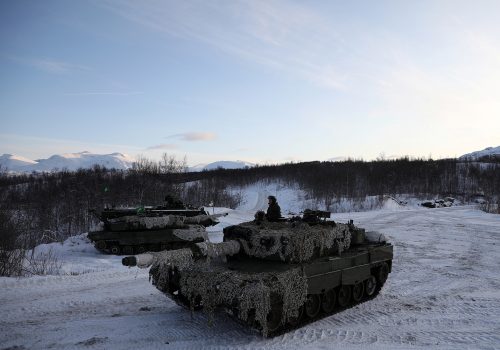The melting Arctic is opening a new front in strategic competition, raising US security concerns in the once-uncontested frontier in a way that echoes the mid-twentieth century Space Race. But unlike the Soviet Union’s Sputnik surprise, which jolted US politics and society, there has been no moment shocking enough to awaken Americans to the threats in, from, and over the Arctic region.
There are numerous externalities: The region opens up opportunities for increasing (or decreasing) the number of sea lines of communication, spying on Arctic nations, stoking competition for natural resources and rare-earth minerals, expanding nations’ military presence, and even illegal fishing. These and other new possibilities may lead to an increased risk of pollution and gas or oil spills, potential sabotage to undersea cables, the displacement of indigenous people, and the disturbance of archeological sites.
Even worse: The United States is falling further behind as its allies and adversaries alike prepare for the new frontier more robustly. Russia and China, for example, have already heightened their activities and ambitions in the region beyond the traditional conceptions of defense, such as nuclear sub-surface power projection and deterrence. Their strategies already include plans to harness exponentially shorter sea lanes, meaning that China and Russia can reach global markets or military targets faster and much more cheaply. There is also the potential for a partnership between the two nations in developing the Northern Sea Route.
Just last week, Russian warships sailed through the Barents Sea as part of a massive naval exercise amid rising tensions between the Kremlin and NATO. To counter the Alliance, Russia has built approximately eight hundred military facilities in the Arctic since 2013. It is also reportedly building numerous airbases in the Arctic, where in July it tested a hypersonic cruise missile.
There is still time for US officials to increase operational capability and strategic effectiveness in the Arctic, and doing so is in the US interest. But in order to catch up to other countries’ preparations, the United States must release a whole-of-government National Arctic Strategy based on an updated National Security Strategy (which is likely to come in early 2022).
Apart from establishing a truly interdepartmental approach to the Arctic—which is currently primarily a maritime domain—it should also draw on capabilities already developed by the United States and its allies for a parallel one: space. Because strategic competition in the Arctic region requires access to the location and more, leveraging technical means, such as commercial space-derived capabilities, is paramount.
Calibrating agencies’ positioning
While the United States has had Arctic plans dating back to US President Richard Nixon’s 1971 National Security Decision Memorandum, its current Arctic strategy was written in 2013—before Washington shifted its focus to strategic competition with Russia and China. Since then, the Arctic has been mentioned only once in the 2017 National Security Strategy, and not at all in the 2018 National Defense Strategy, the 2018 National Military Strategy, or the 2021 Interim National Security Strategic Guidance.
Yet because of its strategic implications for the United States, strategy and policy documents like these must account for the region. The United States must update its National Arctic Strategy to address the emerging realities and national-security interests, but it should not stop there: It must also break down the numerous operational verticals, integrate foreign allies and partners, and assimilate space capabilities for use in the Arctic when necessary.
In September 2021, the White House reactivated the Arctic Executive Steering Committee to advance US Arctic interests as they relate to conducting climate science, addressing the concerns of Indigenous peoples, and enhancing US national and economic security. In its 2016 Implementation Framework for the National Strategy for the Arctic Region, the committee pledged to review US actions in the Arctic, ensuring that they advance US security interests and strategies. But first, the Arctic Executive Steering Committee should look back at this document and assess whether it is still sufficient or relevant—and if not, the committee should explore how to boost its relevance given the changes in the Arctic.
At the cabinet level, the Department of Defense (DoD) has the federal government’s largest Arctic-related budget. In addition to separate documents released by the Army, Navy, and Air Force, it released an updated Arctic strategy in 2019; while this is a noteworthy accomplishment for the DoD, which has long de-prioritized the region, none of these strategies were in any meaningful way coordinated (and thus integrated) with one another. Any update to a National Arctic Strategy should comprehensively bind these DoD documents.
The DoD is not the only department with its eyes on the Arctic: The departments of Homeland Security (DHS), State, the Interior, and Energy are all following developments in the region. Yet besides the DoD, only the DHS (and the Coast Guard, which falls under DHS) has a formal Arctic strategy. In fact, the whole-of-department approach behind the DHS strategy can be scaled up into a broader whole-of-government one by synchronizing interagency efforts and fully leveraging the capabilities, capacity, and partnerships across the entire federal government—not just one or a few departments or agencies.
This broader whole-of-government plan should also include State, Interior, and Energy, which must also begin to develop their Arctic strategies in coordination with the DoD and DHS given their important roles in the region.
Eyes on the stars
Any comprehensive Arctic strategy should also delve into the adjacent domain of space. The Arctic and space are inextricably linked—a fact the Air Force, which spends around six billion dollars per year on its Arctic goals and is the source of about 80 percent of the DoD’s resources to the region, admits in its own Arctic Strategy.
For one, the Arctic’s high latitudes could increase US capabilities to communicate with devices in polar orbits—where spacecraft and satellites already have a strategically advantageous viewpoint. At such heights, space assets can be more effective at everything from environmental and climate monitoring and defense surveillance to astronomical observation, including of those satellites in polar orbit.
But it is a two-way street: US space guidance—such as the National Space Policy, the National Space Strategy, and others—should also be updated to include the Arctic. These updates must consider how the ongoing commercial space boom, along with the digital-infrastructure development it has fueled, can help solve challenges to sustained Arctic operations. For example, space-derived infrastructure can help monitor the operational environment of the Arctic, support climate research, and facilitate modern ways of living in the digital era for people living in Arctic regions.
Finding a north star
Developing an integrated, strategic blueprint aimed at advancing US Arctic interests is an important step—but only the first of several which the government should take. The United States should consider the value of designating an executive agent tasked with leading US Arctic activity. A primary US government lead would focus on planning for Arctic operations and supporting the execution of US Arctic policies, strategies, and plans across the federal government.
The United States is fully capable of increasing operational capability and strategic effectiveness in the Arctic. But to do so, there is an urgent need for a National Arctic Strategy that draws heavily on space-derived capabilities and encompasses a truly whole-of-government approach.
Mir Sadat is a nonresident senior fellow in the Forward Defense practice of the Atlantic Council’s Scowcroft Center for Strategy and Security, a former National Security Council policy and strategy director, and an adjunct scholar at the Modern War Institute. Follow him on Twitter: @Dr_Sadat_USN.
This piece represents the author’s views solely and does not necessarily represent the official policy or position of any department or agency of the US government.
Further reading
Tue, Mar 23, 2021
The Arctic is a place of unusual international cooperation. Can that last?
New Atlanticist By
For decades, Norway’s policy towards neighboring Russia has balanced “between deterrence and reassurance” and combined “firmness and predictability,” says Ine Eriksen Søreide, the country’s minister of foreign affairs. “This policy remains unchanged. But it has become an ever more challenging task in the face of a steadily deteriorating security environment.”
Tue, May 18, 2021
Predictable strategy and unpredictable operations: The implications of agility in Northern Europe
In-Depth Research & Reports By
As the US military becomes increasingly agile, its evolving strategy and activities pose implications for cooperation with allies, deterrence, and stability in Northern Europe.
Fri, Sep 10, 2021
Confronting the disaster left behind in Afghanistan
New Atlanticist By Mir Sadat
The United States screwed up the endgame in Afghanistan once again, but working with allies and private rescue efforts, there's time to make things right.
Image: Warships and support vessels of Russia's Northern Fleet entered the Barents Sea in images released on January 26, 2022. Photo via REUTERS



